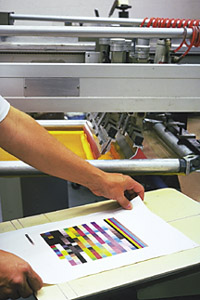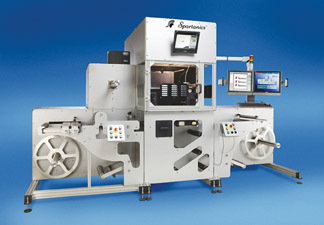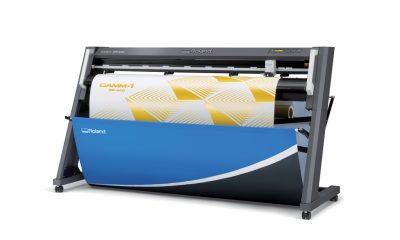Graphics Printing
Published
22 years agoon

With today’s proliferation of color, it’s easy to forget that black-and-white photos, movies, TVs, newspapers, and desktop printers once dominated our lives. In the past, if color was an option at all, it was a luxury. But technology has made full color practical, affordable, and appealing, especially to advertisers who want print promotions to represent their products in color that is realistic or even better than real life.
With today’s proliferation of color, it’s easy to forget that black-and-white photos, movies, TVs, newspapers, and desktop printers once dominated our lives. In the past, if color was an option at all, it was a luxury. But technology has made full color practical, affordable, and appealing, especially to advertisers who want print promotions to represent their products in color that is realistic or even better than real life.
Color issues are part of a larger set of interrelated challenges that screen printers face today. According to the Technology Forecast 2001 released by the Graphic Arts Technical Foundation, four key market trends are influencing all image-reproduction processes: A demand for an increasing number of colors on the typical job. An increase in print complexity on the typical job. A substantial reduction in turn-around time for the typical job. A substantial reduction in the average run length of the typical job.
To remain competitive in light of these trends, many screen printers are beginning to produce process-color graphics. And shops that already have experience with process color are finding themselves obligated to print more process-color work, more predictably, and in a shorter time frame that ever before. What do all these companies have in common? Their success depends on training employees to understand what process-color reproduction is all about and how to make it work with screen printing.
Competitive pressure
For a long time, screen printers were unchallenged in certain niches, including the markets for large-format, short-run, and durable graphics. Then digital technologies emerged, and they seemed poised to take over the business in these niches. While that threat hasn’t become a reality, digital technology has raised the bar on color reproduction and led to a growing demand for high-quality process-color on all graphics–including those that are screen printed.
Wide-format digital imaging evolved in direct response to the need for accurate color, high resolution, and rapid turnaround on short-run graphics. Unlike the screen-printing process with its hundreds of variables, digital imaging leapfrogs labor-intensive prepress and production steps that can send screen-printed color out of control if not performed correctly. Digital technology requires much less operator intervention, making the human factor less influential on the printed result.
So screen printing finds itself with a challenger. And this challenger is very focused on imaging all art as a halftone, or more accurately, as rasterized images. Digital processes have proven themselves very good at producing full-color images and are setting the standard that print buyers expect from screen-printed graphics as well.
In some process-color applications, such as CD and T-shirt printing, screen printers have done very well in reproducing color images. But applications such as these have two big advantages: They involve a small print area, and they are accomplished with multicolor printing machines. Textile applications have the added advantage of affordable multicolor manual presses, which can be used to quickly and inexpensively print proofs on the actual job substrates with the same inks that will be used in production. With large-format graphics, time-consuming press setup makes the generation of press proofs much less cost effective.
Screen printing is feeling the greatest pressure to deliver process-color and the heaviest competition from digital imaging in the markets for decals and medium- to large-format P-O-P displays. These are applications for which multicolor screen-printing machines are fairly new to many printers. This is also the area where the need for process-color education is greatest.
Training for accurate process color
Most of the skills that a screen printer develops are usually learned from the person that previously held the job, from a production manager, or from some other employee. In the average shop, we have lots of people learning from lots of teachers without any reference materials or written guidelines. There are very few standard practices, so each employee does everything in the printing process a little bit differently.
When it comes to producing process-color graphics, these little variations in technique from employee to employee guarantee that you’ll never get the same results twice and lead to unpredictable and inaccurate prints. So it’s clear that standards need to be set, procedures established, and employees trained to adhere to these standards and procedures. But for these standards to make any sense, employees must be taught the fundamental principles behind process-color reproduction.
So are employees getting the kind of process-color training they need? Some new recruits may have had exposure to screen printing through a college or high school course. But few of these programs focus on the production of commercial graphic images, especially process-color ones. A few universities have \"graphic communication\" programs that teach screen printing along with the other printing processes, but again, the focus is likely to be limited.
For most printing shops, the most effective option is to use process-color training resources from within our industry. For example, the Screen Printing Technical Foundation offers regularly scheduled courses on various process-color printing functions. Unfortunately, concerns about expense and loss of manpower mean that few shops take advantage of this type of focused training.
The final training option I’d like to discuss involves programs established by industry suppliers. Some of these occur at the supplier’s facility. Others, such as the program conducted by Nazdar in cooperation with other industry suppliers, are travelling programs that are presented at multiple locations around the country. The latter type allows us to reach far more printers than might otherwise seek training. During the past year, our travelling three-day process-color seminar was presented in 13 locations across the US and drew more than 400 attendees.
One benefit of conducting this program was is that it helped us form a picture about what printers know and don’t know about process-color reproduction. Prior to the start of each seminar we surveyed the attendees to find out what their job positions were, what they hoped to learn, and what problems were occurring most frequently in their four-color printing. Surprisingly, we got very similar answers at each seminar location.
Based on these responses, three areas of process-color reproduction stand out as the greatest challenges for screen printers:
Moiré moiré is a recurring and unpredictable problem for most shops printing halftones at 65 lines/in. or higher.
Dot piling and tonal shifting Dot piling occurs when halftone dots of UV ink are printed on nonabsorbent substrates. The dots create stacked formations that lead to dot gain and a host of other image defects.
Proofing Very few printers understand the proofing process, the proofing systems available, and how to specify a proof in order to predict a screen-printed result.
Each of these problem areas involves circumstances that are unique to screen printing, so process-color training must be similarly specific to the process. However, there are basic principles that apply to all color-reproduction methods, and these fundamentals must also be addressed. The most important of these process color basics are described in the following sections.
Additive and subtractive color theory We have all learned from an early age to understand color as if all color is created from opaque paints. One of the first hurdles to understanding the way process color works it to understand that color is a product of light. We find that most of the people working in art departments understand this since they frequently view images in an RGB mode on their monitors, then convert the image to CMYK for printing. But once the image leaves the art room, most of the other people in the shop don’t understand the importance of how additive (transmitted) and subtractive (reflected) color come together in print reproduction. The role of light in color perception is clearly evident from the confusion that results when a color appears to change because the image is being printed on a different substrate or the graphic is viewed under different lighting than originally.
Proper viewing distance Many screen printers are constantly being pushed by their clients to print halftones at higher line counts. This is the fall out we get when our customers have been working with offset lithographers, who compete with one another on a higher-line-count-is-better basis. But screen printers face a major obstacle in printing higher line counts: mesh interference, which compresses the reproducible tonal range and color gamut we can achieve.
Now consider what happens if the graphic is being reproduced as a medium or large-format piece. To support a high halftone line count, the digital artwork needs to have a high resolution at the desired image size. This leads to huge graphic files that are difficult to store, transmit, and manipulate.
Many of these problems could be avoided if screen printers gave more consideration to viewing distance. In other words, how much detail do we need to provide so that the image looks good at the distance from which the graphic is designed to be viewed? A great deal of process-color screen printing is done at resolutions that far exceed what the viewer will be able to see when the graphic is mounted or hung. Employees need to be taught how to determine the best resolution based on viewing distance, and sales people need training on how to demonstrate this concept to customers.
Reproduction principles
Training should also cover the main influences on process-color accuracy: tonal range, gray balance, and color correction. Printers should understand how to address each of these factors through color management. They need to be familiar with the concept of linearization, which involves determining the reproducible tonal range of each output device (imagesetter, printing press, etc.), then adjusting the tone curves of each separation to compensate and ensure an accurate and predictable printed result. They also need to understand how and why to make gray-balance evaluations and adjustments to provide the right balance of color across the entire image.
Test images and printing to acquire the data on which to assess linearization and gray balance, printers must create, print, and evaluate suitable test images. These images can be created, purchased, or \"borrowed\" from a number of sources throughout the graphic-arts industry.
If things are slow in the shop, creating such a test image from scratch can be a valuable and educational experience for printers. It’s also an effective way to evaluate the print process as well as new products (inks, substrates) you may be asked to print. To assess test prints, printers must be trained in the use of various measuring devices, such as transmission and reflection densitometers.
The practice of generating, measuring, and evaluating prints has been adopted by all the other printing processes as a valuable way to understand and improve image quality. However, the whole concept of printing test images, reading the results, and making changes to improve future print jobs is very foreign to screen printers.
The training environment
To fully understand process-color screen printing, a person must be inquisitive and willing to invest time in training. Moreover, since the whole subject of process-color reproduction is very technical and full of obscure concepts, the best results are attained when training is repetitive.
In our industry, only a handful of the largest, most successful printing operations have established comprehensive in-house training programs to convey these principles on an ongoing basis. More typically, shops rely on external training courses, such as our own travelling seminar program, to educate their employees.
The problem, as we discovered in our own training seminars, is that most participants attend one production-related seminar every two to three years. Many of our students never had been to a structured training program until they attended our course. This means that the ability to repeat and reinforce concepts is limited with external training.
Besides repetitive instruction, employees also benefit from a hands-on approach to training, particularly with a complicated, multistep procedure like process-color screen printing. Obviously, training in the workplace with the actual tools used for production is the ideal environment. But if an external source is the only practical option, then find one that incorporates as much hands-on training as possible.
It’s also important that any training program, in house or external, encourages interaction between the trainer and the students. Demonstrations and examples should be followed by an open forum in which participants can share experiences, problems, and solutions and ask questions related to the training program or their own process-color printing experience.
Training starts at the top
At the end of our seminars, we always ask attendees to fill out a critique/comment form. The responses we get on these forms unanimously acknowledge that we have been providing information in a way that the attendees can understand, which is great!
But the forms also indicate that absence of real decision makers, people that can put a plan into action and make sure valuable new ideas are incorporated into a business’s day-to-day procedures. So production workers leave the training program energized with ideas to solve common problems. But they often end up frustrated, finding little interest or support for their ideas and having no authority to enact useful procedures and methods themselves.
You can’t overlook training if your aim is to produce high-quality process-color graphics. Whether you hone workers’ skills in house or use outside training courses to educate employees, make sure your commitment covers the fundamentals of color theory, incorporates hands-on practice, and reinforces concepts through repetition. Finally, keep the lessons alive after class ends by giving workers the tools they need to fine-tune production and allowing them to put their new ideas into action.
About the author
Bruce Ridge is director of product and process-application training for Nazdar, Shawnee, KS, a manufacturer of screen-printing and digital-imaging inks. Ridge develops and implements the company’s training programs on screen-printing products and application methods for both employees and customers. His background includes positions in product development and sales and seven years operating an award-winning graphics screen-printing business. Ridge holds a bachelor’s degree in graphic communications from California Polytechnic Institute, San Luis Obispo, CA and associate degrees in graphic design and technical illustration.

Subscribe

Magazine
Get the most important news
and business ideas from Screenprinting Magazine.
Most Popular
-

 Case Studies2 months ago
Case Studies2 months agoHigh-Density Inks Help Specialty Printing Take Center Stage
-

 Art, Ad, or Alchemy2 months ago
Art, Ad, or Alchemy2 months agoF&I Printing Is Everywhere!
-

 Andy MacDougall2 months ago
Andy MacDougall2 months agoFunctional and Industrial Printing is EVERYWHERE!
-

 Columns3 weeks ago
Columns3 weeks ago8 Marketing Mistakes Not to Make When Promoting Your Screen Printing Services Online
-

 Editor's Note3 weeks ago
Editor's Note3 weeks agoLivin’ the High Life
-

 Marshall Atkinson3 weeks ago
Marshall Atkinson3 weeks agoHow to Create a Winning Culture in Your Screen-Printing Business
-

 Thomas Trimingham2 months ago
Thomas Trimingham2 months ago“Magic” Marketing for Screen Printing Shops
-

 News & Trends2 months ago
News & Trends2 months agoWhat Are ZALPHAS and How Can You Serve Them in Your Print Business?






